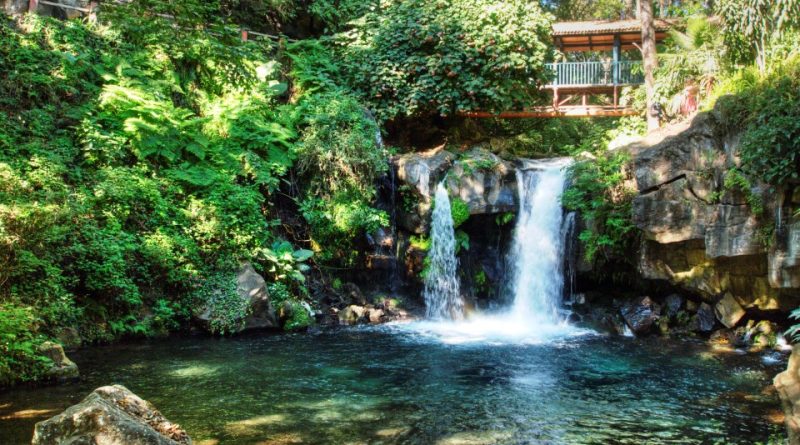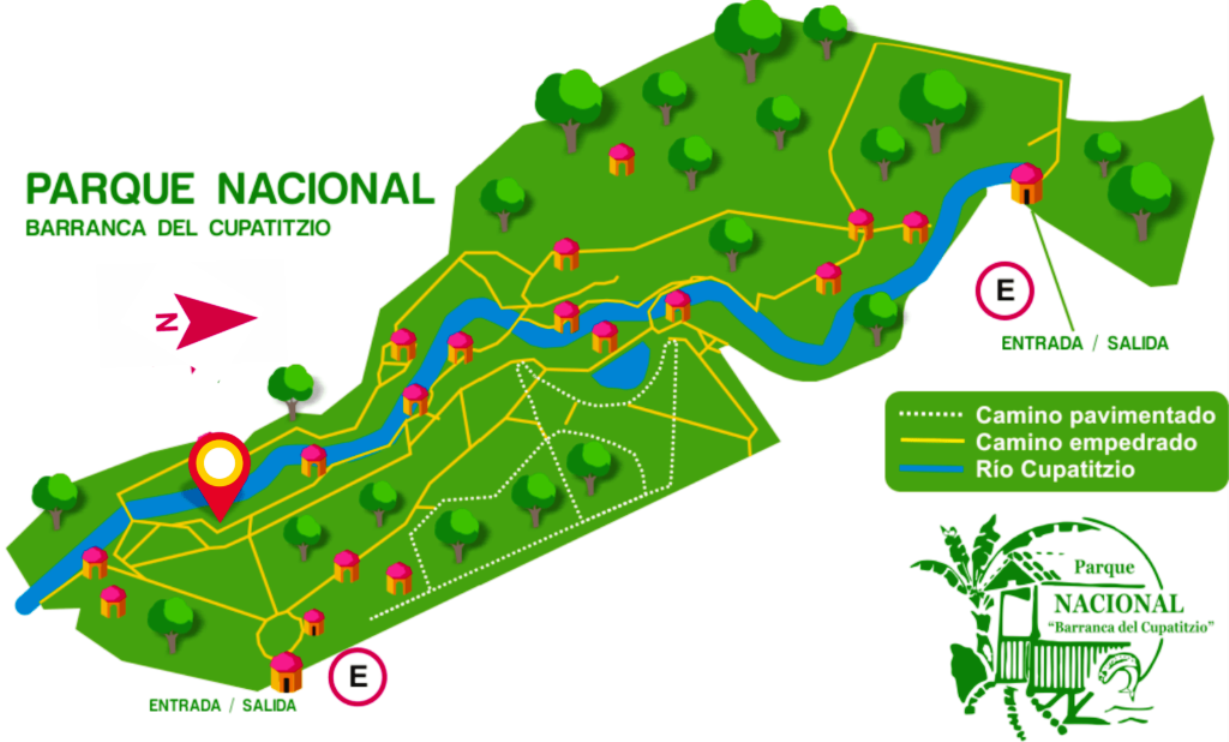Barranca del Cupatizio National Park
Barranca del Cupatizio National Park
Barranca del Cupatitzio National Park is a national park in the Mexican state of Michoacán, centered on the headwaters of the Cupatitzio River. The river emerges from an underground spring, carving out a small ravine as the water begins to flow. The park is known for its abundant streams and springs, many of which cascade down the sides of the ravine forming small waterfalls.
This area was declared a federally protected zone in 1938, after the land was purchased by the Mexican government to create a recreational area. Most of the park is located in the northwestern part of the municipality of Uruapan, while the rest is located in the neighboring municipality of Nuevo Parangaricutiro. The park is largely urban, with the most popular section entirely surrounded by the city of Uruapan. Inside the ground is soft and moist, with broad-leaved temperate and tropical vegetation, several walking paths near the river and some artificial fountains built on the sides of the ravine to take advantage of the natural waterways. The park attracts tens of thousands of visitors every year.
Geography –
Barranca del Cupatitzio National Park, also known as Uruapan National Park, is located in the state of Michoacán, Mexico. This park is famous for its natural beauty, especially the waterfalls and the Cupatitzio River which flows through a beautiful ravine.
The park is located in the city of Uruapan, in central Michoacán. Uruapan is known as the “avocado capital” of Mexico due to its significant avocado production.
The most prominent feature of the park is the ravine, which is a deep and steep canyon carved by the Cupatitzio River. This canyon is surrounded by lush vegetation, which includes a wide variety of trees, plants and flowers.
Inside the park you will find several impressive waterfalls. The most famous is the Tzaráracua Waterfall, which falls from a considerable height and creates a beautiful natural pool at its base. Other notable waterfalls include Cascada del Rincón de Parangueo and Cascada del Estribo.
The Cupatitzio River flows through the ravine and is mainly responsible for the formation of the waterfalls and the scenic beauty of the park. The river is clean and crystal clear, making it ideal for activities such as swimming and hiking along its banks.
The Barranca del Cupatitzio National Park is a popular destination for nature lovers, hikers and tourists who want to enjoy a splendid natural environment. It offers an excellent opportunity to explore the geography of the region and enjoy the beauty of its waterfalls, forests and mountainous landscapes.
Climate –
Uruapan is located in the central area of Mexico and is characterized by a subtropical climate. Average temperatures vary throughout the year. Below is some general information about the climate in the region:
– Average temperatures can vary from warm to hot throughout the year. Average maximum temperatures can exceed 30 degrees Celsius in summer, while winter temperatures are generally milder, with average minimums around 10 degrees Celsius.
– The region may experience rain during much of the year. The rainy season usually runs from June to September, with peak rainfall in July and August.
– Humidity can vary considerably throughout the year, with higher levels during the rainy season.
– The altitude of the Barranca del Cupatizio National Park can influence the local climate. The variation in temperatures may be more marked in the surrounding mountainous areas.
Flora –
The Barranca del Cupatizio National Park features a great diversity of flora, including pines, oaks and other tree species. You will also find ferns, orchids and many other plants that thrive in this humid, mountainous environment.
Low deciduous forest: This is the predominant vegetation in the park. It includes trees such as copal, guamúchil, tabachín, huamúchil, rosewood and guaje tree. These trees lose their leaves during the dry season.
Vegetation Gallery: Along the rivers and streams that run through the park, you can find lush vegetation, including trees such as willows and cottonwoods, as well as aquatic plants such as reeds and cattails.
Secondary vegetation: in areas where deforestation or agricultural activities have taken place in the past, it is possible to find secondary vegetation composed of fast-growing shrubs and trees such as cacti, mesquite, huizache and pochote
Orchids and Bromeliads: The park is home to a variety of orchids and bromeliads that grow on trees and rocks. Some notable species include the orchid Encyclia michoacanensis and the bromeliad Tillandsia recurvata.
Medicinal plants: There are several plants in the region with medicinal properties used by local communities. Some of them are epazote, rue and arnica.
Mosses and Lichens: In humid and shaded areas it is common to find mosses and lichens which contribute to the biodiversity of the ecosystem.
Cactaceae: In the drier areas of the park you can find different species of cactus, such as the cactus, characteristic of the region.
The flora of the Barranca del Cupatizio National Park is varied and unique, and these are just some of the species you can find in this beautiful place. In addition to flora, the park is also home to a wide variety of fauna, including birds, mammals and reptiles. It is an important place for biodiversity conservation in the region.
Fauna –
The area of the Barranca del Cupatizio National Park is rich in biodiversity and is home to a variety of animal species, such as birds, butterflies, amphibians and small mammals. Some of the birds that can be seen in the park include hummingbirds and woodpeckers.
Among the faunal species present in the Barranca del Cupatitzio National Park we remember:
– Birds: the park is home to a variety of birds, including species such as the quetzal, the hummingbird, the brown blackbird, the king vulture and many other birds that populate the forests and canyons of the region.
– Butterflies: the park is the ideal place to observe butterflies. Several butterfly species, including the monarch butterfly, migrate to this region at certain times of the year.
– Mammals: Among the mammals present in the park we find the puma, the jaguarundi, the ocelot, the white-tailed deer, the opossum and the armadillo.
– Amphibians and reptiles: The park is home to various species of amphibians and reptiles, such as tree frogs, snakes, lizards and freshwater turtles.
– Fish: A variety of fish species can be found in the rivers and streams of the region.
Guido Bissanti


